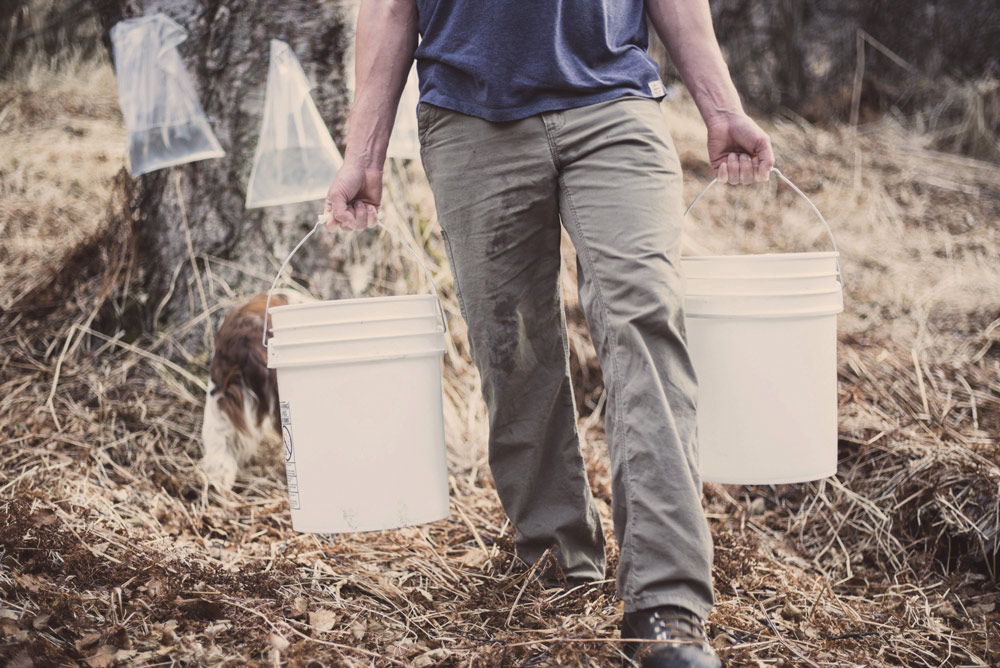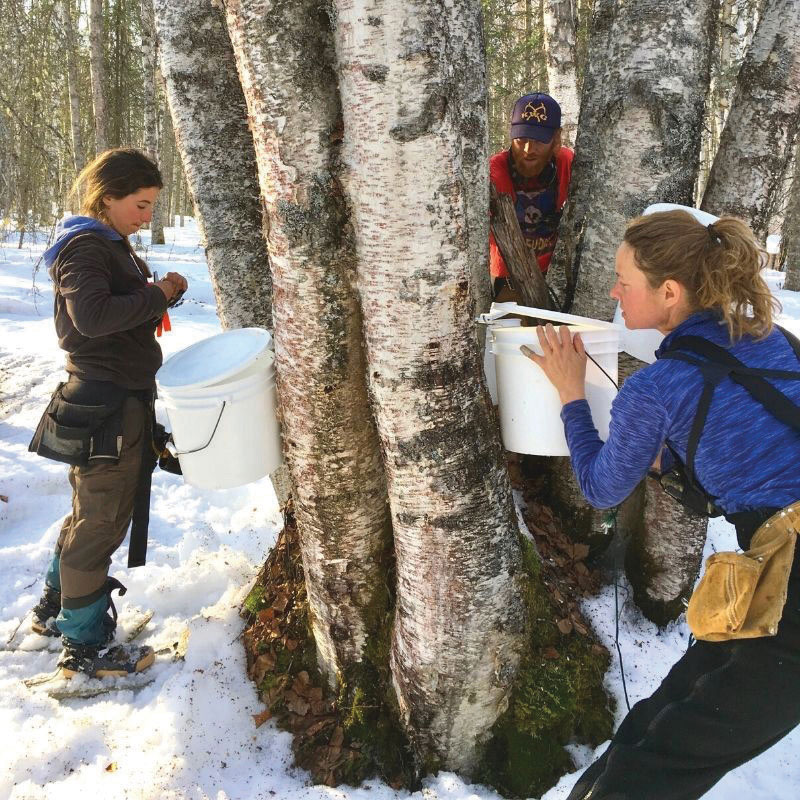ulk salt sells for pennies per ounce. Alaska Pure Sea Salt Company, though, sells 4-ounce pouches for $14 apiece.
“A lot of people in town thought we had lost our marbles,” says Jim Michener, who co-owns the Sitka-based company with his wife. As they were starting more than a decade ago, he recalls neighbors scoffing, “Why would I pay this price that seems outrageous for a product I can buy at the grocery store for a percentage of that?”
Over time, the community began to understand the product, and Michener says Sitkans are now the company’s biggest advocates. When cruise ship visitors inundate the town, locals tell tourists they absolutely must visit the salt store.
The Micheners make a finishing salt. “It’s not thrown into food during a mixing or cooking process; it’s being used at the end. The food is plated, so you see these beautiful, geometric, shiny crystals on top. When you bite into it, there’s a textural component: a light, delicate crunch that is incredibly appealing,” Michener explains.
Extracted from the waters of Sitka Sound, the salt also conveys a unique taste. “Even in the sea salt world, if you’re critically tasting, there is quite a bit of difference in the flavor of it,” Michener says. “Having a balanced flavor is key. When you talk about flake salt, that’s really the appeal for high-end restaurants, chefs, and enthusiastic home cooks.”
Jake Beaudoin, co-owner of Bridge Creek Birch Syrup in Homer, speaks of his product much the same way. “There’s a lot of different flavor profiles to it,” Beaudoin says. “There’s three different main runs—there’s the early run, there’s the mid-run, then there’s the late run—and there’s a huge change in flavor.”
The sweetener and the seasoning have another commonality: both are food ingredients manufactured from Alaska’s natural surroundings.
North of Homer, Beaudoin and his partner, Anna Meredith, don’t like using a computer at their homestead. They prefer to sell birch syrup at farmers markets, but Bridge Creek Birch Syrup also supplies five value-added manufacturers, such as Chugach Chocolates in Anchorage. Meredith says, “We pick and choose because we’re so small. We don’t have a lot of product, so we pick the ones that we really want to enjoy for ourselves.”
Evidently, Meredith and Beaudoin enjoy ice cream. “Yes, we are proud to use birch syrup from Bridge Creek Birch in Homer,” says Elissa Brown, owner of Wild Scoops. “We’ve been buying from them since we first opened in 2015.”
Wild Scoops also uses flake salt from Sitka for its cookies and salted caramel.
Michener and his wife are the “old guard” of Alaska salt. Michener made his first batch in 1999. “It was on our honeymoon that we accidentally left a big pot of seawater on a wood stove unattended overnight,” he recalls. “Woke up in the morning to find a heavy brine with salt forming on the surface. It lit the fire of, ‘Hey, let’s make some salt and use it in our kitchen at home.’”

Alaska Wild Harvest

By contrast, Meredith was practically born into the syrup industry. At least, she grew up making maple syrup at her family’s dairy farm in New York. Beaudoin had made birch syrup at home, growing up in Homer, but it became his career mainly because hardly anybody else was doing it.
Just a handful of suppliers make birch syrup in Alaska. Michael and Dulce East are pioneers in the field, starting in 1990. They established Kahiltna Birchworks in Talkeetna, which grew into Alaska Wild Harvest. This summer, they retired and sold the business to Ted and Alex Hammers and Chris Sorensen.
Beaudoin credits Michael East with helping Bridge Creek Birch Syrup get going. “Michael helped me out a ton. I talked to him every year. He’s saved me a lot of heartache by little tidbits, how to do things, good advice,” Beaudoin says. “I’m not sure where it’s going to go, but we’ll find out, I guess.”
In addition to bulk syrup, Alaska Wild Harvest makes birch candies and other fruit syrups, which Wild Scoops resells at its ice cream shop. Brown says, “If we didn’t use local products, it would certainly be cheaper to produce our ice cream, but it would take away one of the things that makes Wild Scoops so unique.”
“We buy five gallons of honey at a time, so there is some bulk savings there,” Brown explains. “We use it as part of our honeycomb candy add-in for our AK Honeycomb flavor, so we are able to stretch it out more than if we just used it straight in the ice cream.”
Alaska wildflowers offer a feast for hungry bees in the state’s surprisingly extensive honey-making network. “There’s a decent-sized beekeeping community in Alaska,” says Patrick Cotter, owner of Alaska Honey Collective in Fairbanks. He figures his area alone might have 200 or more insect whisperers.
Most are backyard hobbyists, and Cotter’s collective is small, too: just him and the bees. Since he started in 2016, he’s been looking for ways to expand, which would require larger property to host hives. (His neighbors, he says, don’t seem to mind the insects buzzing around.)
Committing to wholesale orders is tricky, Cotter says, because he can’t guarantee quantity. The honey harvest in late August may vary in volume depending on summer weather. Cotter continues selling through the winter, doing a lot of business for Christmas.


Alaska Wild Harvest
At Wild Scoops, “We don’t use the syrup and honey as alternative sweeteners; they are specific flavors that we try to highlight as special add-ins,” Brown says. “But it’s certainly a balance. We need to make sure that we can produce ice cream at a reasonable price so we can also sell it at a reasonable price and stay financially sound.”
That’s when he uses a Top Bar hive, where bees attach combs to a horizontal bar. He also uses Langstroth hives: stacked boxes with wooden frames that give bees a head start on comb construction. To harvest honey from the frames, he spins them inside of a metal tub.
The bees do most of the manufacturing. They slurp nectar from flowers, spit it into honeycomb cells, and maintain the hive environment to drive off water until the sugar is thickened.
Evaporation is the key to birch syrup, too. “It comes in as raw sap, which is essentially water with 1 percent sugar in it,” Beaudoin explains. “We run it through a reverse osmosis machine that I built, which essentially extracts pure water from it, and then you’re left with the concentrate.”

Jake Beaudoin
Wild Scoops

Michener’s process also starts with 1,000 gallons and removes the unwanted water. Converting seawater into packaged salt takes six days, which includes sanitizing, filtering, and multiple evaporation stages. Several batches are processed concurrently.
Seawater is “basically free,” he adds, but “evaporative costs are tremendous.” In cloudy, rainy Sitka, brine pans can’t be left outdoors. Salt is manufactured with indoor evaporators.
“I’m not proud of my carbon footprint,” Michener says. He conceived of the business as carbon neutral, relying on Sitka’s hydropower, but the city denied his permit because his plant’s electricity consumption could cause a brown-out.
Sitka’s hydroelectric capacity has since increased, and Michener has engineering drawings for a more energy-efficient facility. However, he’d need to move out of his leased warehouse space, and finding waterfront land is a challenge.
Until then, Alaska Pure Sea Salt Company is locked into using propane heaters.
While Bridge Creek’s main market for birch syrup is locals, the product also appeals to tourists. “They just want to take that flavor home. It’s just nice to be able to purchase a gift that isn’t going to hang around forever, too. It’s like flowers: it goes away,” says Meredith.
Salt is another flavor that tourists take home. “A lot of people are looking for Alaska-made products,” Michener says. “That really fits the bill for us; we have a product that’s locally made from start to finish. It also is small, so it’s easy to travel with. And it’s consumable, so it’s a good gift. We do quite well with the visitor trade.”
Alaska Honey Collective does a couple thousand dollars’ worth of sales per year, and Cotter says about half his customers are in the Lower 48. “I think there’s a mystique about anything from Alaska,” he says. “Our honey tastes different depending on the floral sources and everything. Depending on where you have your hives, the bees can get a lot of nectar from fireweed, which I think has a unique taste. There’s not a lot of apiaries out there that can say that.”
To make birch syrup, Bridge Creek relies on other people’s property. “This year we worked with six landowners,” Meredith says. “We get agreements, and they’re excited that a product is coming off their property and they don’t have to do it themselves. We trade them a year’s supply of birch syrup.”
Syrup, Beaudoin believes, has terroir, like wine. “You go upstate, its syrup tastes totally different. I think we’re really lucky here. I think our trees have a higher sucrose content,” he says. “That’s one thing that we’re blessed with down here. Good, light, delicious, buttery.”
Does sea salt have the marine equivalent, a merroir? Michener has heard of it, but he doesn’t think so, generally. “I imagine if you went to the mudflats of Turnagain Arm, stirred it up, and got some of that stinky hydrogen sulfide mud,” he conjectures, “maybe you’d end up with some of that skunky, eggy smell. But for the most part, whether you’re pulling the water from Sitka or San Francisco, if you’re just talking about seawater, there should be no difference.”
That said, Michener concedes that the lack of heavy industry in Sitka Sound makes some difference. Furthermore, “Any sea salt that’s made properly is a tremendously different product from what you consider salt: sodium chloride in the Morton’s bottle with the umbrella.” Michener notes that Alaska Pure Sea Salt Company is the only domestic producer of flake finishing salt.
Unlike gold or oil, the resources that go into these food ingredients are practically everywhere. No one has to explore for seawater, wildflowers, or birch trees.
“I don’t know why more don’t make it,” Meredith says of potential growth in the birch syrup industry. Not enough people know about it, she supposes.
Beaudoin would like to change that. “My goal is to make something that’s good enough to sell itself,” he says. “It’s taking a long time, but our process has been refined, and I do believe I’m very proud to put it out there.”